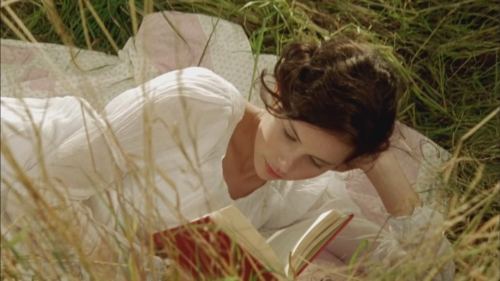More than any other Jane Austen novel, Northanger Abbey chases the reader around with a morality hammer until it finally hits you over the head with “DO NOT LET YOUR IMAGINATION GET THE BETTER OF YOU!”
This is the first full novel Austen completed, so we have
to be forgiving that her usual nuance is a bit clumsy and uneven. The gist of the storyline is simple: naïve
clergyman’s daughter Catherine Morland is plucked from her idyllic country life
and taken to The Big City of Bath to be introduced to society by a family friend. She makes several friends, but in her naïveté
she tends to make them indiscriminately: some are quality and good-hearted,
others have ulterior motives. But like
Austen’s inexperienced writing, we forgive Catherine for being ignorant,
because she’s too ignorant to know any better.
 |
| Source: http://24.media.tumblr.com/b6d774e0a82c4b661aadc8a76c81f680/tumblr_mhw1etSJOF1qlpapgo1_500.jpg |
Catherine’s main flaw, then, is being a bit of a drama glutton. She loves gothic novels. (If she were a real person alive today, she would be part of the Paranormal Romance craze.) Not to give away too much of the plot, but it’s pretty obvious from the beginning that Catherine’s gullibility combined with a penchant for horrific secrets in decrepit and creepy castles is not a good combination and will not end well. Especially when she is invited by a friend to the decrepit and creepy Northanger Abbey.
Thinking about how Austen satirizes the gothic novel—she
makes fun of Catherine’s idea that the master of Northanger Abbey has secretly
killed his wife—makes me wonder if this novel is the reason that Charlotte
Bronte of Jane Eyre fame hated Austen. Jane Eyre is about a young woman who is invited to a creepy
castle where her employer has a secret...Austen would have had a field day with
Bronte’s brooding hero Mr. Rochester, if only Austen had been alive to have a
field day at all.
Northanger Abbey is probably my least favorite of
Austen’s novels…although that is not saying much
considering the level of love I harbor for the rest of her works. The reason is that a lot of the humor of NA is “embarrassment humor.” You know those sitcoms where the main
character is caught rifling through their boyfriend’s room and stands there
making a face that can only be described as
O_O ?*
I hate those moments. I used to run out of the room or hide behind the recliner when I thought
such a moment was coming on whichever television show I was watching. So when Catherine’s bubble of gothic fantasy
is burst, I can’t help but cringe.
That said, there is actually a lot of other interesting
stuff going on in the book. Most of this
stuff is not even noticed by our heroine (who’s too busy seeking out crypts of
murder victims to see the actual intrigue around her). Austen uses the other characters to show that
Catherine is not the only one who lives in a fantasy or believes convenient
untruths about another person because it will suit their own selfish ends.
So, delving deeper than the “don’t let your imagination
run wild” moral, there might be an even deeper theme to Northanger Abbey:
People are more complicated than your perception of them. Catherine’s lowest moment comes from treating
people like fictional characters that can be divided into romantic victims and
evil villains. The real villains of the
book treat the people around them as either rungs on the social ladder or
impediments to their ambitions. We do
the same thing in real life by classifying people according to how popular or
talented or their personalities, rarely searching for the complex facets of
each personality we meet. Individuals
are more than jocks, cheerleaders, geeks, quiet or boisterous, friendly or
shy. Instead each individual is a
combination of a multitude of different traits, each combined in a unique way
that takes time and effort on our part to see and understand.
Odd how things like fictional characters teach us how to
understand real life people.
*This is of course a technical term.
Recommended Reading Age: 13+
Parental Notes: It’s parodied, but the whole gothic feel
may be too much for sensitive younger teens.
Availability: I love how the Penguin Classics edition has
keys all over it.
Adaptations: There are two adaptations of note: 1987’s BBC adaptation which has some horrific images to enhance the gothic experience,
and the newer 2007 adaptation which is a lot more explicit with the “reality”
scenes. My personal preference is for the
newer version because the 1987 version’s Tilney is kind of creepy and out of
character.
No comments:
Post a Comment